A Scenario-Based Framework to Optimising Eco-Wellness Tourism Development and Creating Niche Markets: A Case Study of Ardabil, Iran
Abstract
1. Introduction
- What are the key natural factors that contribute to the success and attractiveness of eco-wellness tourism products?
- What are the potential scenarios for the development of eco-wellness tourism, and how do these scenarios impact the optimal allocation of resources?
Contribution to Existing Knowledge
2. State of the Art
2.1. Spatial Perspectives on Eco-Wellness Tourism
2.2. Wellness and Nature-Based Tourism
2.2.1. Water-Based Therapy
2.2.2. Climate-Based Therapy
2.2.3. Kinetic-Based Therapy
3. Study Area
4. Materials and Methods
4.1. Data
4.2. Methods
4.2.1. Effective Criteria
4.2.2. Standardization of Criteria Maps
4.2.3. Criteria Weighting
4.2.4. Scenario-Based Spatial Analysis and Modeling
4.2.5. Spatial and Statistical Analysis
4.2.6. Ensemble Analysis
5. Results
5.1. Water-Based Eco-Wellness Tourism
5.2. Climate-Based Eco-Wellness Tourism
5.3. Kinetic-Based Eco-Wellness Tourism
5.4. Water, Climate and Kinetic: An Ensemble Approach to Eco-Wellness Tourism
6. Discussion
Limitations of the Study
7. Conclusions
Author Contributions
Funding
Institutional Review Board Statement
Informed Consent Statement
Data Availability Statement
Conflicts of Interest
References
- Jónás-Berki, M.; Csapó, J.; Pálfi, A.; Aubert, A. A market and spatial perspective of health tourism destinations: The Hungarian experience. Int. J. Tour. Res. 2015, 17, 602–612. [Google Scholar] [CrossRef]
- Lee, J.T.; Han, J.-S.; Ko, T.-G. Health-oriented tourists and sustainable domestic tourism. Sustainability 2020, 12, 4988. [Google Scholar] [CrossRef]
- Najafinasab, M.; Agheli, L.; Sadeghi, H.; Dizaji, S.F. Identifying and prioritizing strategies for developing medical tourism in the social security organization of Iran: A SWOT-AHP hybrid approach. Iran. J. Public Health 2020, 49, 1959. [Google Scholar] [CrossRef] [PubMed]
- Dryglas, D.; Salamaga, M. Segmentation by push motives in health tourism destinations: A case study of Polish spa resorts. J. Destin. Mark. Manag. 2018, 9, 234–246. [Google Scholar] [CrossRef]
- Kazemi, N. Healing With Nature to Develop Health Tourism in Iran. Sci. Cultiv. 2023, 14, 55–61. [Google Scholar]
- Sánchez-Sánchez, F.J.; Sánchez-Sánchez, A.M. Ecotourism and COVID-19: Impact on the efficiency of the Spanish hospitality industry. J. Outdoor Recreat. Tour. 2023, 43, 100680. [Google Scholar] [CrossRef]
- Groulx, M.; Wigglesworth, J.; DeLorey, R.; Harris, N.; Harris, P.; Lamb, H.; McBride, C. Not for all: Barriers to universal accessibility in nature-based tourism and recreation spaces across British Columbia, Canada. J. Outdoor Recreat. Tour. 2024, 47, 100772. [Google Scholar] [CrossRef]
- Liao, C.; Zuo, Y.; Xu, S.; Law, R.; Zhang, M. Dimensions of the health benefits of wellness tourism: A review. Front. Psychol. 2023, 13, 1071578. [Google Scholar] [CrossRef] [PubMed]
- Ridderstaat, J.; Singh, D.; DeMicco, F. The impact of major tourist markets on health tourism spending in the United States. J. Destin. Mark. Manag. 2019, 11, 270–280. [Google Scholar] [CrossRef]
- Lee, J.; Kim, H.-B. Success factors of health tourism: Cases of Asian tourism cities. Int. J. Tour. Cities 2015, 1, 216–233. [Google Scholar] [CrossRef]
- Lee, C.-W.; Li, C. The process of constructing a health tourism destination index. Int. J. Environ. Res. Public Health 2019, 16, 4579. [Google Scholar] [PubMed]
- Pessot, E.; Spoladore, D.; Zangiacomi, A.; Sacco, M. Natural resources in health tourism: A systematic literature review. Sustainability 2021, 13, 2661. [Google Scholar] [CrossRef]
- Faisal, M.; Dhusia, D. Health Tourism: A New Driver for Development. Adv. Econ. Bus. Manag. 2020, 7, 50–56. [Google Scholar]
- Mancini, M.S.; Barioni, D.; Danelutti, C.; Barnias, A.; Bračanov, V.; Pisce, G.C.; Chappaz, G.; Đuković, B.; Guarneri, D.; Lang, M.; et al. Ecological Footprint and tourism: Development and sustainability monitoring of ecotourism packages in Mediterranean Protected Areas. J. Outdoor Recreat. Tour. 2022, 38, 100513. [Google Scholar] [CrossRef]
- Didaskalou, E.A.; Nastos, P. The role of climatic and bioclimatic conditions in the development of health tourism product. Anatolia 2003, 14, 107–126. [Google Scholar] [CrossRef]
- Asadzadeh, M.; Vatankhah, S.; Aryankhesal, A. The main city branding dimensions in health tourism development: A scoping review. J. Contemp. Issues Bus. Gov. 2021, 27, 6446–6460. [Google Scholar]
- Zhong, L.; Deng, B.; Morrison, A.M.; Coca-Stefaniak, J.A.; Yang, L. Medical, health and wellness tourism research—A review of the literature (1970–2020) and research agenda. Int. J. Environ. Res. Public Health 2021, 18, 10875. [Google Scholar] [CrossRef]
- Jaksic-Stojanovic, A.; Jankovic, M.; Seric, N. Montenegro as a high-quality health tourism destination: Trends and Perspectives. Afr. J. Hosp. Tour. Leis. 2019, 17, 93–95. [Google Scholar]
- Heydari, R.; Fathololoumi, S.; Soltanbeygi, M.; Firozjaei, M.K. A Sustainability-Oriented Spatial Multi-Criteria Decision Analysis Framework for Optimizing Recreational Ecological Park Development. Sustainability 2025, 17, 731. [Google Scholar] [CrossRef]
- Pooya, M.R.; Hasankhani, A.; Fathololomi, S.; Karimi Firozjaei, M. A Spatial Multi-Criteria Decision-Making Approach to Evaluating Homogeneous Areas for Rainfed Wheat Yield Assessment. Water 2025, 17, 1045. [Google Scholar] [CrossRef]
- Salehipour, M.; Kazemi, N.; Jokar Arsanjani, J.; Karimi Firozjaei, M. Developing a Multi-Criteria Decision Model to Unlock Sustainable Heritage Tourism Potential. Sustainability 2025, 17, 3703. [Google Scholar] [CrossRef]
- Vulevic, A.; Roy, S.; Castanho, R.A.; Franco, M.; Couto, G. Exploring the Geo-Tourism Potential and Its Accessibility in Danube Region Serbia: A Geo-Statistical Approach. In Urban Agglomeration—Extracting Lessons for Sustainable Development; IntechOpen: Rijeka, Croatia, 2024. [Google Scholar]
- Firozjaei, M.K.; Nematollahi, O.; Mijani, N.; Shorabeh, S.N.; Firozjaei, H.K.; Toomanian, A. An integrated GIS-based Ordered Weighted Averaging analysis for solar energy evaluation in Iran: Current conditions and future planning. Renew. Energy 2019, 136, 1130–1146. [Google Scholar] [CrossRef]
- Mijani, N.; Alavipanah, S.K.; Hamzeh, S.; Firozjaei, M.K.; Arsanjani, J.J. Modeling thermal comfort in different condition of mind using satellite images: An Ordered Weighted Averaging approach and a case study. Ecol. Indic. 2019, 104, 1–12. [Google Scholar] [CrossRef]
- Shorabeh, S.N.; Firozjaei, M.K.; Nematollahi, O.; Firozjaei, H.K.; Jelokhani-Niaraki, M. A risk-based multi-criteria spatial decision analysis for solar power plant site selection in different climates: A case study in Iran. Renew. Energy 2019, 143, 958–973. [Google Scholar] [CrossRef]
- Firozjaei, M.K.; Sedighi, A.; Jelokhani-Niaraki, M. An urban growth simulation model based on integration of local weights and decision risk values. Trans. GIS 2020, 24, 1695–1721. [Google Scholar] [CrossRef]
- Rezvani, M.; Nickravesh, F.; Astaneh, A.D.; Kazemi, N. A risk-based decision-making approach for identifying natural-based tourism potential areas. J. Outdoor Recreat. Tour. 2022, 37, 100485. [Google Scholar] [CrossRef]
- Smith, M.; Puczkó, L. More than a special interest: Defining and determining the demand for health tourism. Tour. Recreat. Res. 2015, 40, 205–219. [Google Scholar] [CrossRef]
- Plzáková, L.; Crespo Stupková, L. Environment as a key factor of health and well-being tourism destinations in five European countries. IBIMA Bus. Rev. 2019. [Google Scholar] [CrossRef]
- Pan, X.; Yang, Z.; Han, F.; Lu, Y.; Liu, Q. Evaluating potential areas for mountain wellness tourism: A case study of Ili, Xinjiang Province. Sustainability 2019, 11, 5668. [Google Scholar] [CrossRef]
- Utama, I.; Nyandra, M. Health and Wellness Tourism Industry: Types and Development Potentials in Bali, Indonesia. Int. J. Soc. Sci. Educ. Res. Stud. 2021, 1, 8–12. [Google Scholar]
- Dada, Z.A.; Baba, S.N.; Qureshi, R.A. Thermal heritage and wellness tourism development in the trans–Himalayas using GIS site suitability analysis. Int. J. Spa Wellness 2023, 6, 131–156. [Google Scholar] [CrossRef]
- Hojcska, Á.E.; Szabó, Z. Investigating natural treatment factors and inequalities of medicinal water institutions in the aspect of tourism in Hungary. Geo J. Tour. Geosites 2021, 36, 555–562. [Google Scholar] [CrossRef]
- Ramkissoon, H.; Majeed, S. Health, wellness and place attachment during and post health pandemics. Front. Psychol. 2020, 11, 573220. [Google Scholar] [CrossRef]
- Amininia, K.; Abad, B.; Safarianzengir, V.; GhaffariGilandeh, A.; Sobhani, B. Investigation and analysis of climate comfort on people health tourism in Ardabil province, Iran. Air Qual. Atmos. Health 2020, 13, 1293–1303. [Google Scholar] [CrossRef]
- Li, Y.; Zhang, S.; Han, J.; Zhao, Y.; Han, Q.; Wu, L.; Wang, X.; Qiu, Z.; Zou, T.; Fan, C. A study of the temporal and spatial variations in the suitability of the environment in Chinese cities for tourism and in strategies for optimizing the environment. Int. J. Digit. Earth 2022, 15, 527–552. [Google Scholar] [CrossRef]
- Dunets, A.N.; Yankovskaya, V.; Plisova, A.B.; Mikhailova, M.V.; Vakhrushev, I.B.; Aleshko, R.A. Health tourism in low mountains: A case study. Entrep. Sustain. Issues 2020, 7, 2213. [Google Scholar] [CrossRef]
- Zhang, S.; Chi, L.; Zhang, T.; Wang, Y. Spatial Pattern and Influencing Factors of Tourism Resources in Northwestern Ethnic Areas in China—A Case Study of Longde County. Int. J. Environ. Res. Public Health 2022, 19, 16684. [Google Scholar] [CrossRef]
- Yessengabylova, A.; Bekbulatova, A.; Suraganova, S.; Bissekov, A.; Zhumanova, B. Recreational Potential of Kazakhstan and Prospects of Medical Health Tourism in This Country. Int. J. Environ. Sci. Educ. 2016, 11, 8447–8469. [Google Scholar]
- Büyüközkan, G.; Mukul, E.; Kongar, E. Health tourism strategy selection via SWOT analysis and integrated hesitant fuzzy linguistic AHP-MABAC approach. Socio-Econ. Plan. Sci. 2021, 74, 100929. [Google Scholar] [CrossRef]
- Wang, K.; Xu, H.; Huang, L. Wellness tourism and spatial stigma: A case study of Bama, China. Tourism management 2020, 78, 104039. [Google Scholar] [CrossRef]
- Yan, X.; He, S. The co-evolution of therapeutic landscape and health tourism in bama longevity villages, China: An actor-network perspective. Health Place 2020, 66, 102448. [Google Scholar] [CrossRef]
- Muhi, B.; Đurković, J.V. Analysis of health tourism in the republic of Serbia and the Czech Republic. In Modern Management Tools and Economy of Tourism Sector in Present Era; Udruženje Ekonomista i Menadžera Balkana: Belgrade, Serbia, 2020; pp. 227–240. [Google Scholar]
- Fouladi, N.; Habibzadeh, S.; Barari, S.; Alimohammadi Asl, H.; Homayounfar, N.; Nemati, A. Factors affecting medical trip from the perspective of Azerbaijani tourists, Iran 2016. J. Health Care 2018, 20, 252–260. [Google Scholar] [CrossRef]
- Chen, K.-H.; Chang, F.-H.; Wu, C. Investigating the wellness tourism factors in hot spring hotel customer service. Int. J. Contemp. Hosp. Manag. 2013, 25, 1092–1114. [Google Scholar] [CrossRef]
- Liu, X.; Fu, Y.; Li, J. The effect of on-site experience and place attachment on loyalty: Evidence from Chinese tourists in a hot-spring resort. Int. J. Hosp. Tour. Adm. 2019, 20, 75–100. [Google Scholar] [CrossRef]
- Backman, S.J.; Huang, Y.-C.; Chen, C.-C.; Lee, H.-Y.; Cheng, J.-S. Engaging with restorative environments in wellness tourism. Curr. Issues Tour. 2023, 26, 789–806. [Google Scholar] [CrossRef]
- Erfurt-Cooper, P.; Cooper, M. The health and wellness concept: A global overview. In Health and Wellness Tourism: Spas and Hot Springs; Erfurt-Cooper, P., Cooper, M., Eds.; Channel View Publications: Bristol, UK, 2009. [Google Scholar]
- Kazakov, S.; Oyner, O. Wellness tourism: A perspective article. Tour. Rev. 2021, 76, 58–63. [Google Scholar] [CrossRef]
- Ebrahimzadeh, I.; Sakhavar, N.; Taghizadeh, Z. A comparative study of health tourism potentials in Iran and India. J. Subcont. Res. 2013, 5, 51–78. [Google Scholar]
- Pu, B.; Du, F.; Zhang, L.; Qiu, Y. Subjective knowledge and health consciousness influences on health tourism intention after the COVID-19 pandemic: A prospective study. J. Psychol. Afr. 2021, 31, 131–139. [Google Scholar] [CrossRef]
- Armaitiene, A.; Bertuzyte, R.; Vaskaitis, E. Conceptual framework for rethinking of nature heritage management and health tourism in national parks. Procedia-Soc. Behav. Sci. 2014, 148, 330–337. [Google Scholar] [CrossRef]
- Farajzadeh, H.; Matzarakis, A. Evaluation of thermal comfort conditions in Ourmieh Lake, Iran. Theor. Appl. Climatol. 2012, 107, 451–459. [Google Scholar] [CrossRef]
- Mrčela, N.T.; Borovac, J.A.; Vrdoljak, D.; Grazio, S.; Luetić, A.T.; Tomek-Roksandić, S. When elders choose: Which factors could influence the decision-making among elderly in the selection of health tourism services? Med. Hypotheses 2015, 85, 898–904. [Google Scholar] [CrossRef]
- Gerami, F.; Hosseini, S.Z.; Ashtari, M.N.; Fadaei, H. Identifying the Potential of Health Tourism in Pasargadae Region, Iran. Athens J. Tour. 2019, 6, 277–292. [Google Scholar] [CrossRef]
- Mojaradi, Z.; Bozorgi-Amiri, A.; Hashemzadeh, S. Strategic Planning for Supply Chain of Health Tourism in Iran: Razavi Hospital. Razavi Int. J. Med. 2021, 9, 21–33. [Google Scholar]
- Calderwood, L.U.; Soshkin, M. The Travel and Tourism Competitiveness Report 2019; World Economic Forum: Cologny, Switzerland, 2019. [Google Scholar]
- Khiavi, R.F. Health Tourism Development Strategies in Ardabil. Int. J. Travel Med. Glob. Health 2014, 2, 65. [Google Scholar]
- Golshiri, Z.; Roknodineftekhari, A.; Pourtaheri, M. Modeling of health tourism development in rural areas of Iran (Hot springs). J. Tour. Plan. Dev. 2015, 3, 11–32. [Google Scholar]
- Saaty, T.L. How to make a decision: The analytic hierarchy process. Eur. J. Oper. Res. 1990, 48, 9–26. [Google Scholar] [CrossRef]
- Akbarian Ronizi, S.R.; Mokarram, M.; Negahban, S. Investigation of Sustainable Rural Tourism Activities With Different Risk: A GIS-MCDM Case in Isfahan, Iran. Earth Space Sci. 2023, 10, e2021EA002153. [Google Scholar] [CrossRef]
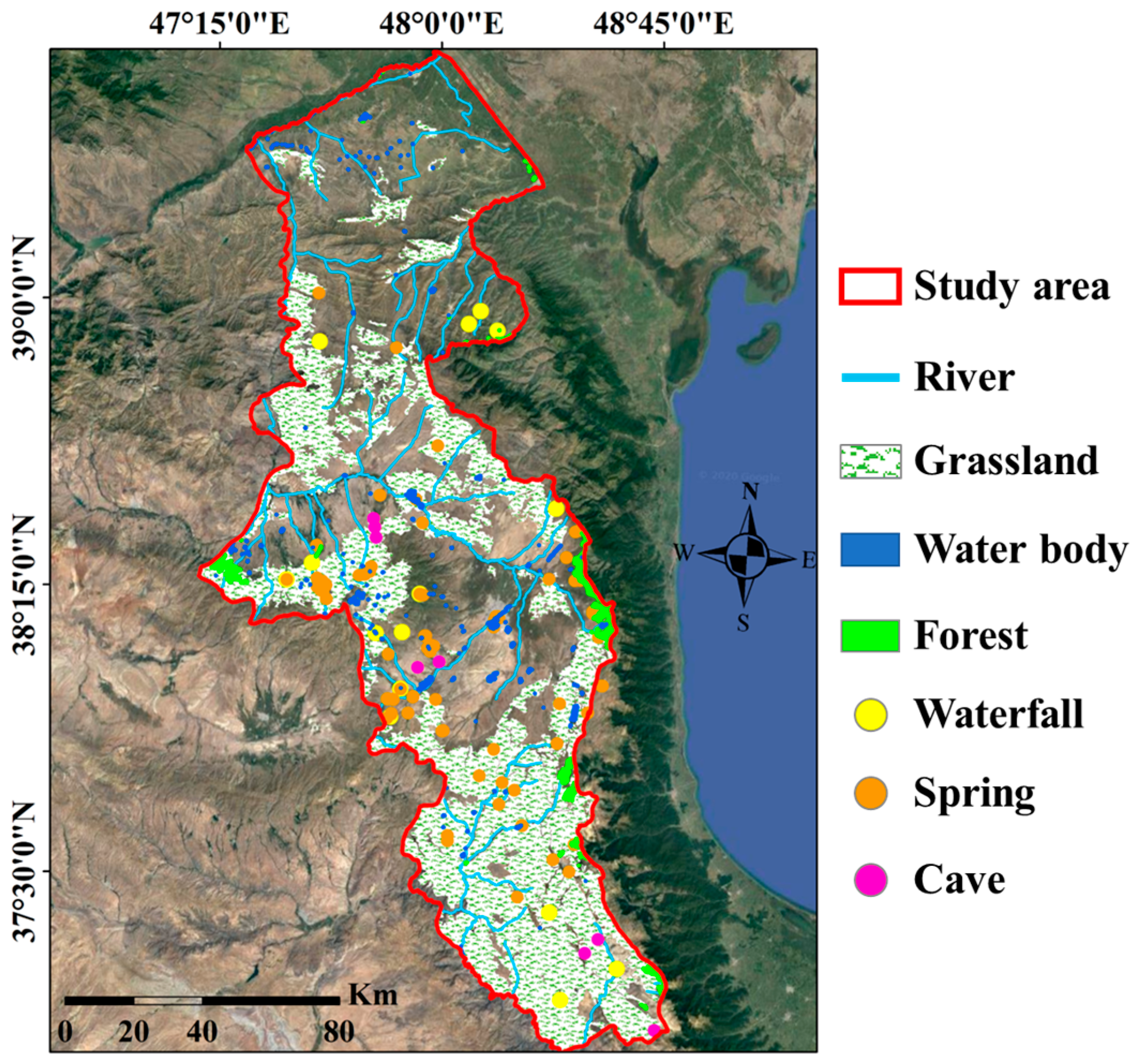
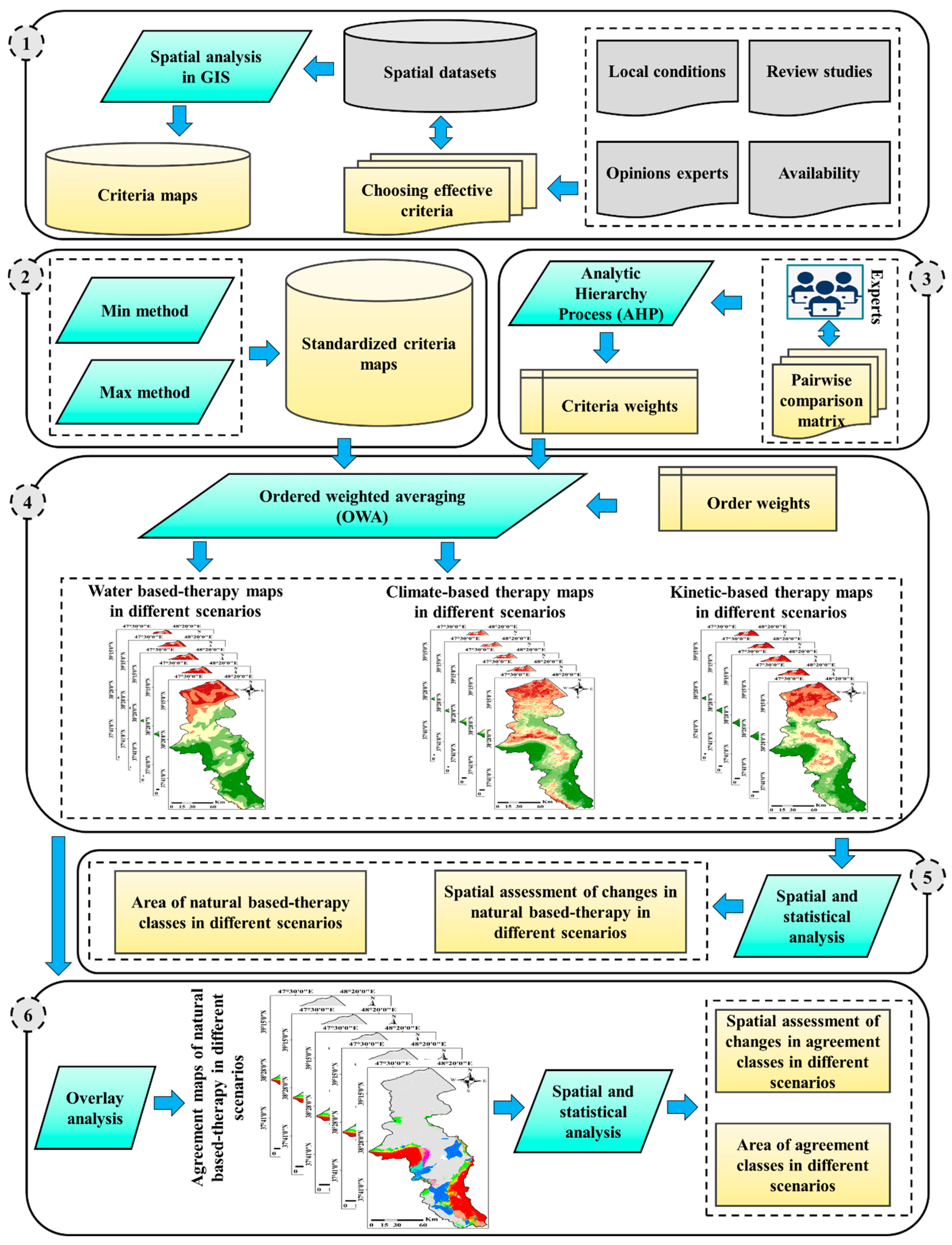
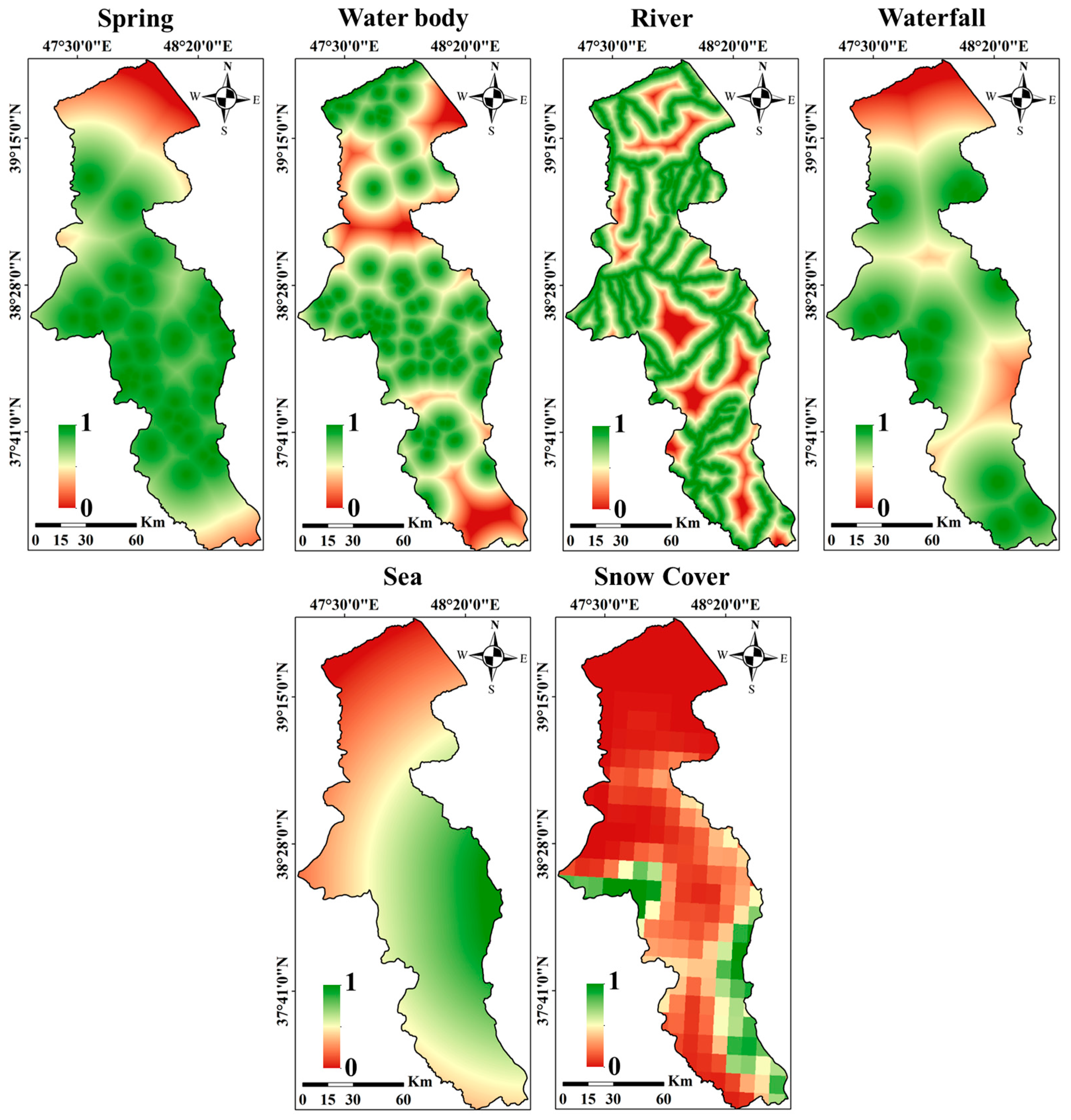


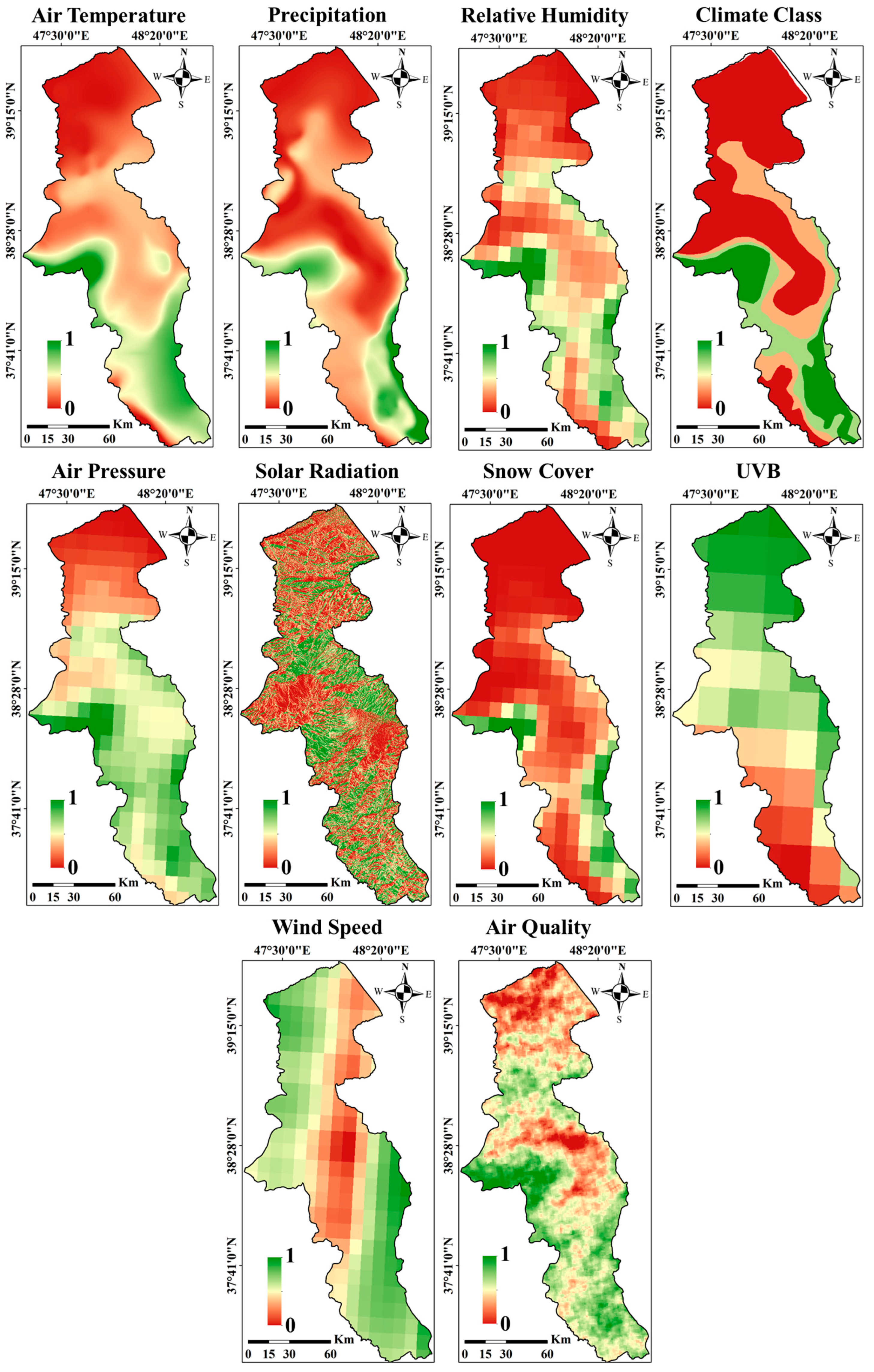
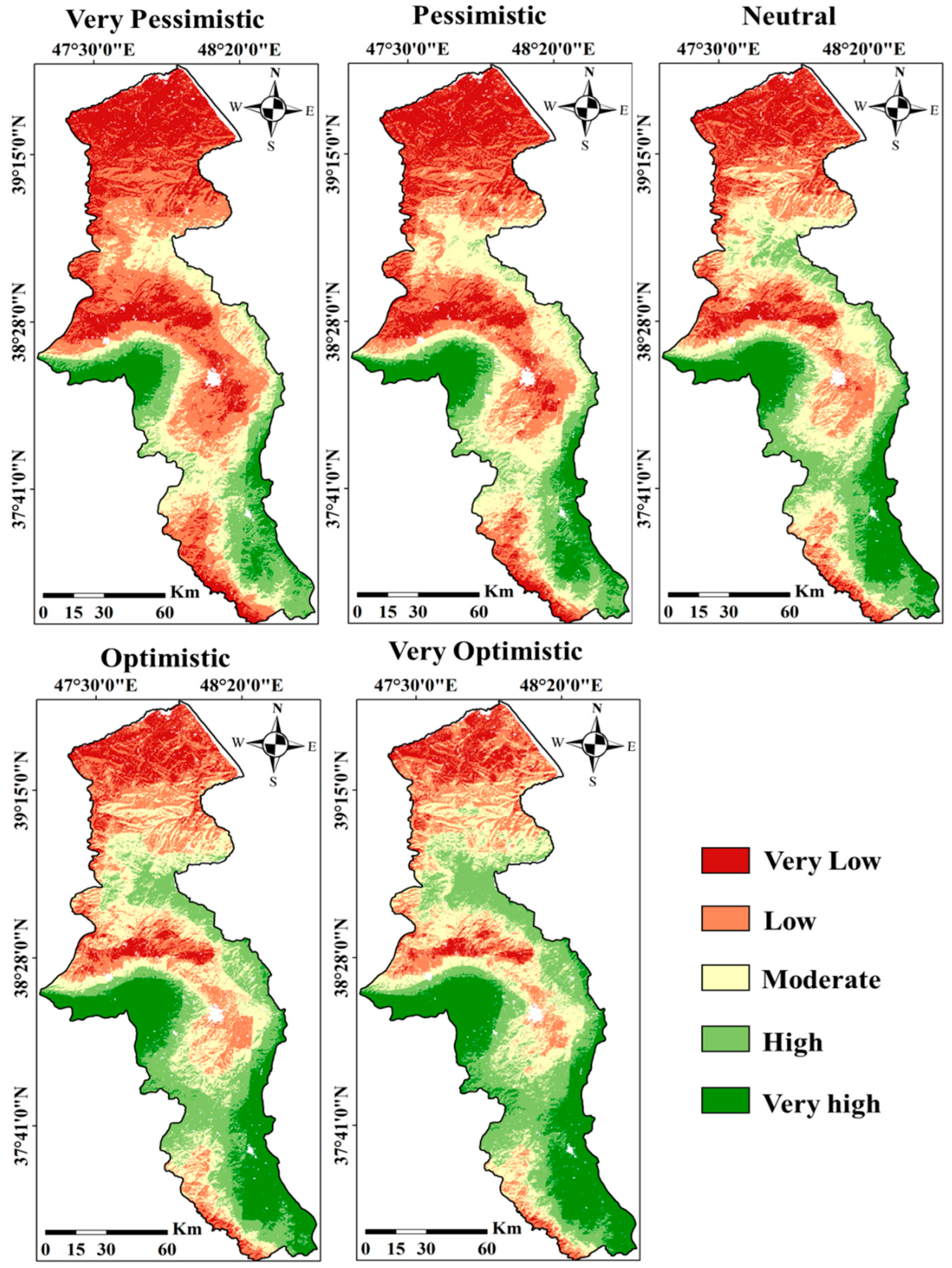
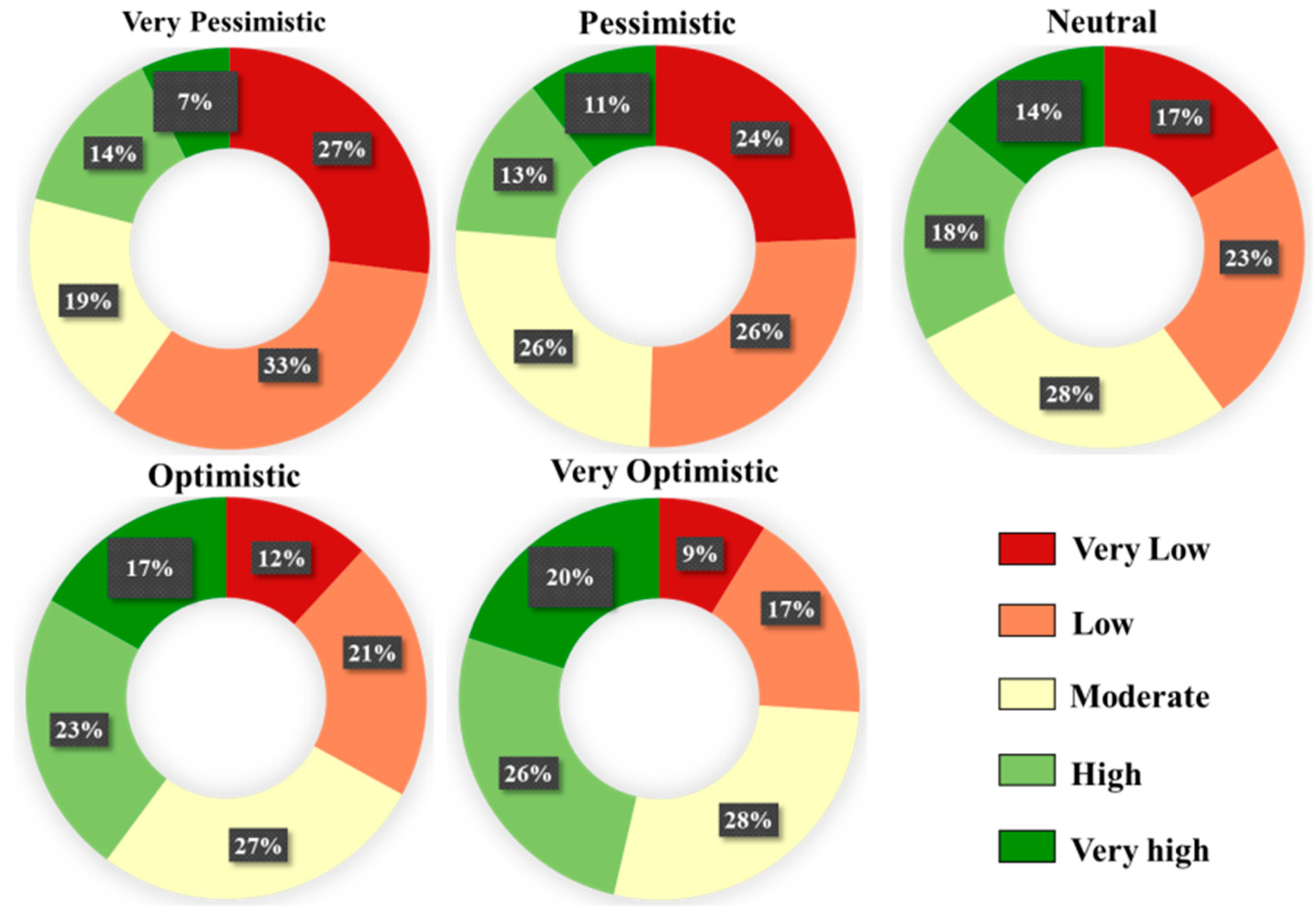
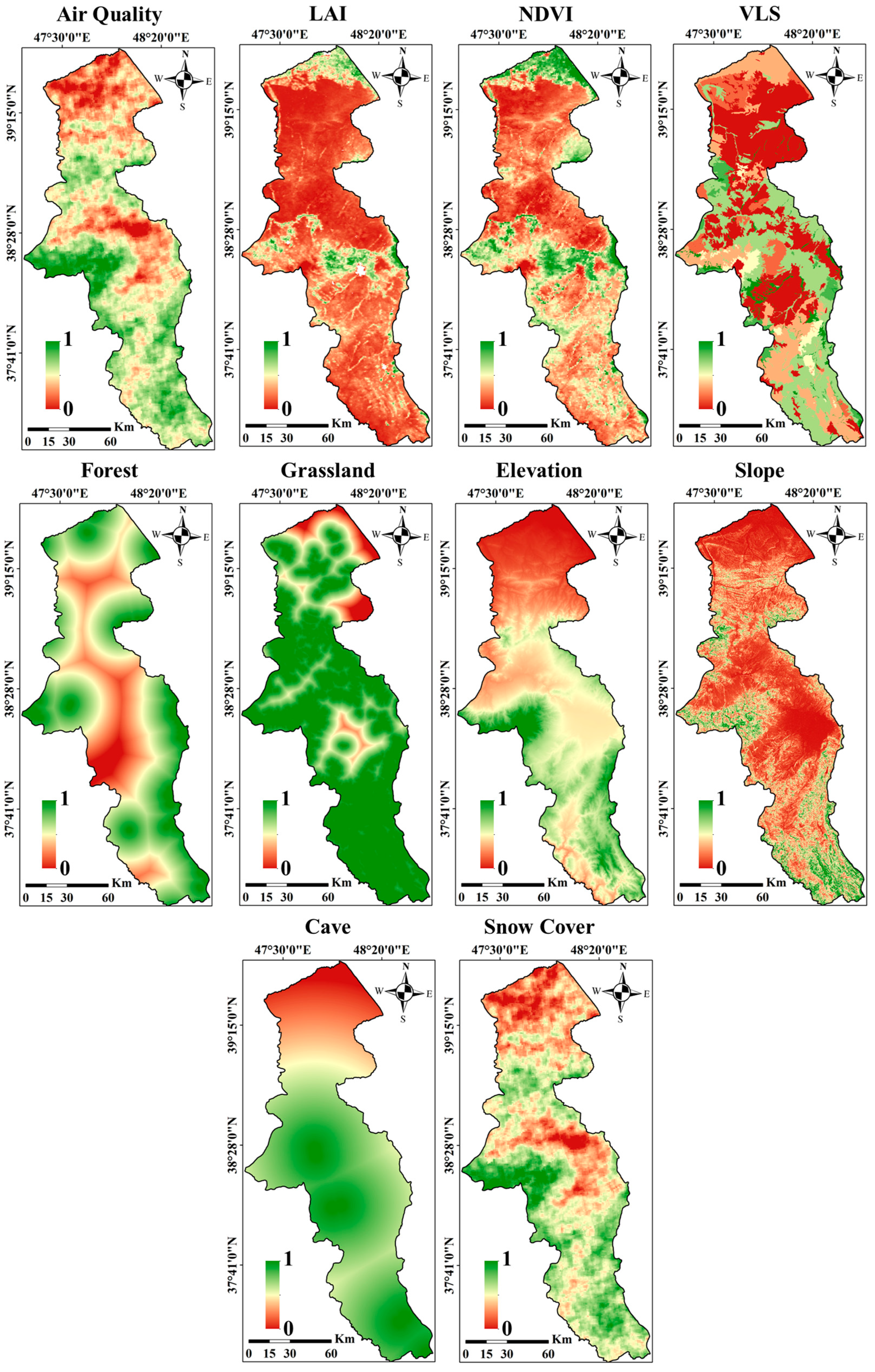
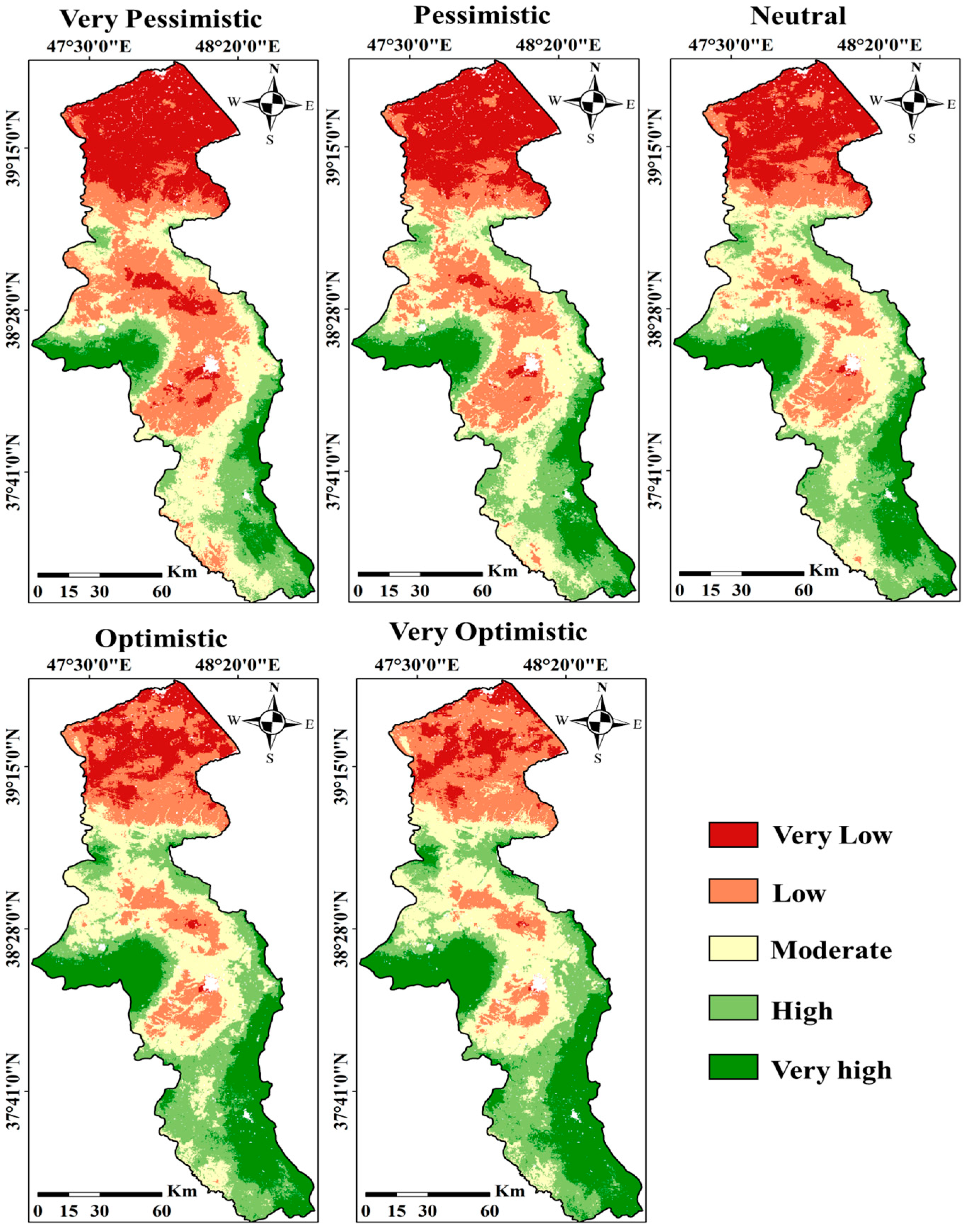
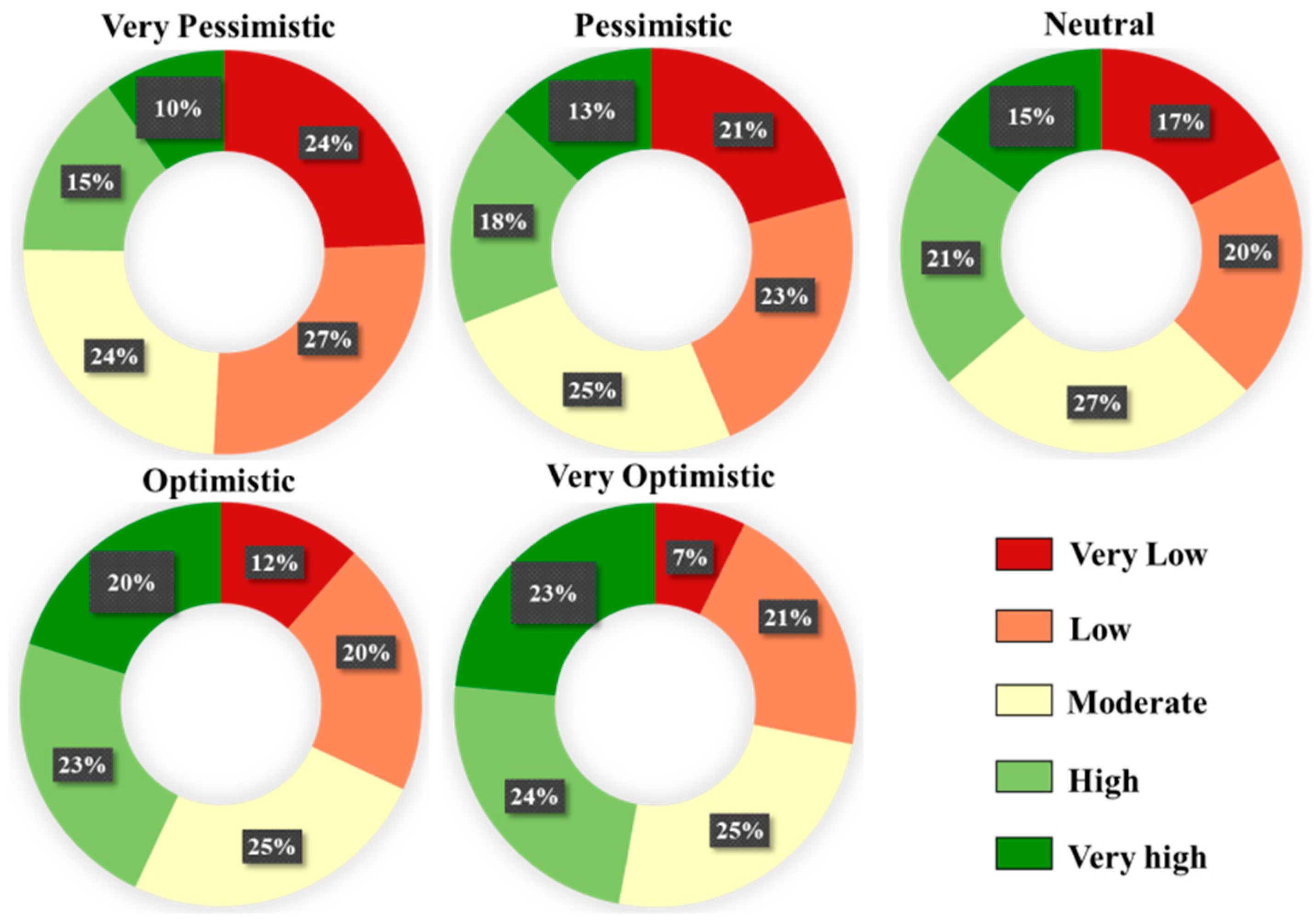
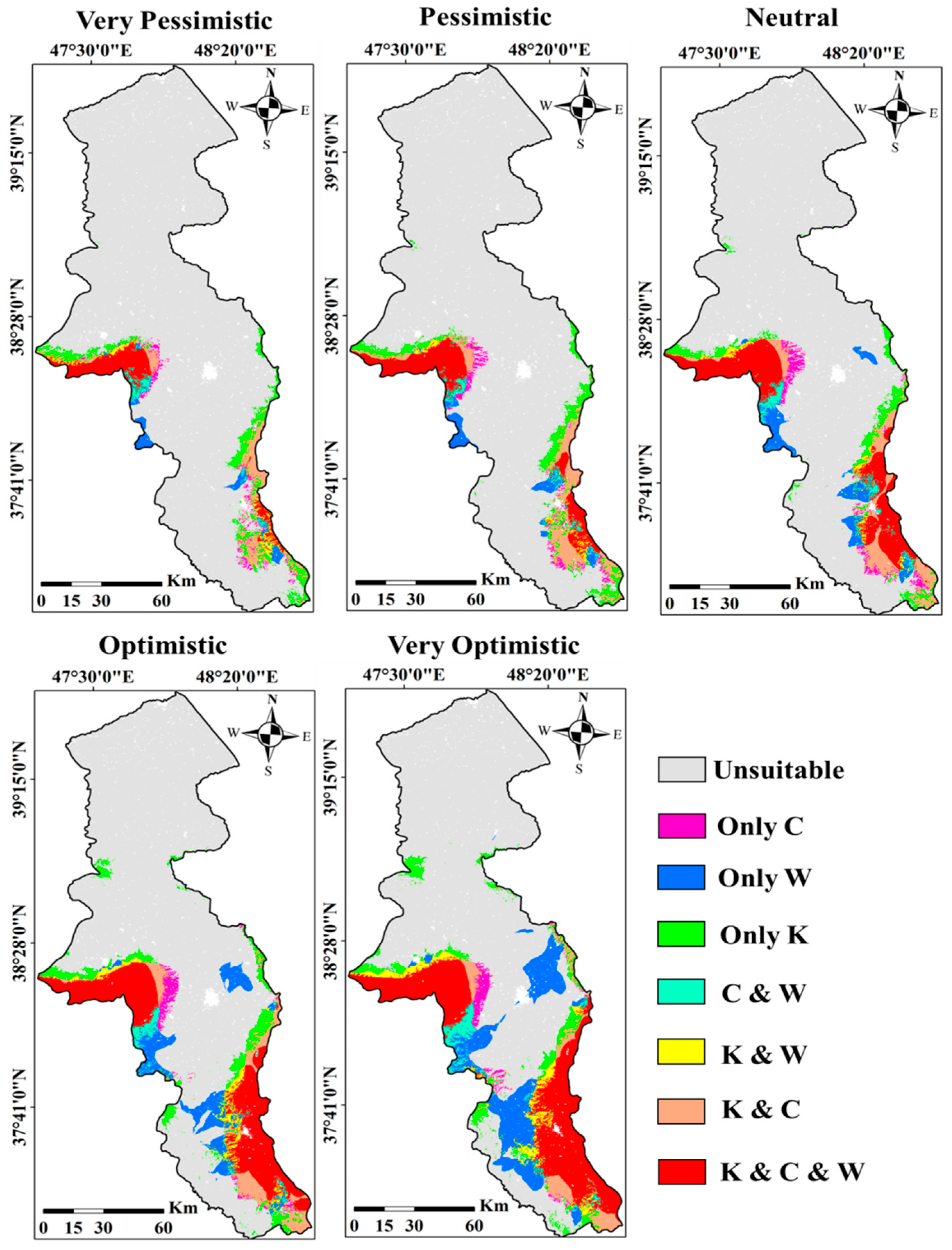
| Data | Type | Descriptions | Website (Access Date) |
|---|---|---|---|
| Land cover, Forest, Grassland, Water body, Vegetation landscape | Shapefile (Polygon) | Land cover, including shapefiles for Forest, Grassland, Water body, Vegetation landscape was extracted from the Land Use Shapefile of Iran provided by the Iranian Natural Resources and Watershed Management Organization. | https://en.frw.ir/ (accessed on 5 April 2025) |
| Mountains | The shapefile for mountainous areas was derived from a digital elevation model. The AW3D model with a 30 m spatial resolution was used. | https://www.aw3d.jp/en/products/standard/ (accessed on 5 April 2025) | |
| Climate class | The Climate class map was derived from the Climate shapefile of Iran, provided by the Iranian Meteorological Organization. | https://www.irimo.ir/eng/index.php (accessed on 5 April 2025) | |
| River and Coastline | Shapefile (Polyline) | The shapefile for rivers and coastline in Ardabil Province was extracted from the river dataset provided by the Ministry of Energy. | https://new.moe.gov.ir/ (accessed on 4 April 2025) |
| Air temperature | The Air temperature and Precipitation maps were derived from the isotherm and isohyet shapefiles of Iran, provided by the Iranian Meteorological Organization. | https://www.irimo.ir/eng/index.php (accessed on 4 April 2025) | |
| Precipitation | |||
| Spring | Shapefile (Point) | The shapefile for Spring was extracted from the Spring dataset provided by the Ministry of Energy. | https://new.moe.gov.ir/ (accessed on 4 March 2025) |
| Waterfall and Cave | The shapefile for Waterfall and Cave was extracted from the Google earth and Open Street map database. | https://earth.google.com/web/ (accessed on 28 March 2025) https://www.openstreetmap.org/ | |
| Air quality | Raster | The Air quality map was derived from the Sentinel 3 Greenhouse Gas Products/MOD04 AOD from MODIS Terra with a 1000 m spatial resolution. | https://www.esa.int/Applications/Observing_the_Earth/Copernicus/Sentinel-3/Data_products (accessed on 28 March 2025) https://modis.gsfc.nasa.gov/data/dataprod/ (accessed on 28 March 2025) |
| Snow cover | The snow cover map was derived from the MOD10A1.061 Terra Snow Cover with a 500 m spatial resolution. | https://modis.gsfc.nasa.gov/data/dataprod/ (accessed on 28 March 2025) | |
| NDVI and LAI | The NDVI and LAI maps were derived from the MOD13A3 V6.1 NDVI and MOD15A2H.006 LAI Products with a 1000 m spatial resolution | ||
| Topography (Elevation), Slope, Landform and Solar radiation | The topographic map, slope map, landform map, and solar radiation map were derived from the AW3D digital elevation model with a 30 m spatial resolution. | https://www.aw3d.jp/en/products/standard/ (accessed on 27 March 2025) | |
| UVB | The UVB map was derived from the glUV Products with a 25,000 m spatial resolution. | https://www.ufz.de/gluv/index.php?en=32435 (accessed on 29 March 2025) | |
| Wind speed, Surface Pressure and Relative humidity | The Climatic factors maps were derived from the ECMWF Reanalysis v5 (ERA5) Products with a 3000 m spatial resolution | https://www.ecmwf.int/en/forecasts/dataset/ecmwf-reanalysis-v5 (accessed on 29 March 2025) |
| Eco-Wellness Product | Criteria | Descriptions |
|---|---|---|
| Water | Springs | Greater proximity to natural springs facilitates easier access for tourists seeking therapeutic mineral baths and spa treatments, enhancing the overall appeal of the location for eco-wellness tourism. |
| Sea and lakes | Proximity to large water bodies like seas and lakes offers opportunities for a variety of water-based eco-wellness activities such as swimming, boating, water sports, and thalassotherapy, attracting tourists seeking diverse eco-wellness experiences. | |
| Rivers | Rivers provide access to activities like river rafting, kayaking, and stand-up paddleboarding, which can be incorporated into eco-wellness resorts and adventure-based tourism packages. Proximity to rivers also enhances the scenic beauty of the location. | |
| Waterfalls | Waterfalls offer stunning visual appeal and can be incorporated into eco-wellness resorts through activities like waterfall meditation, sound therapy, and invigorating mist treatments. | |
| Water body | Closer proximity to any water body, regardless of its specific type, increases the potential for water-based recreational activities, enhancing the appeal of the location for tourists seeking eco-wellness experiences related to water. | |
| Snow cover | Snow cover directly influences the availability of meltwater, which supports water resources such as rivers and lakes. Additionally, snow-covered landscapes enhance the aesthetic appeal and provide unique opportunities for eco-wellness activities in natural winter settings. | |
| Climate | UVB | Excessive exposure to UVB rays can lead to skin damage, increased risk of skin cancer, and other health issues. Therefore, areas with high UVB radiation may deter tourists seeking outdoor activities and physical eco-wellness experiences. |
| Air quality | Clean air is crucial for respiratory eco-wellness. Resorts located in areas with excellent air quality can offer activities like forest bathing, yoga retreats, and meditation sessions, emphasizing the benefits of fresh air and reduced pollution. | |
| Climate class | Favorable climate classes, with mild temperatures and clean air, create ideal conditions for promoting physical and mental well-being. | |
| Temperature | Temperature is a key factor in the comfort and suitability of outdoor eco-wellness activities, with mild and stable temperatures enhancing relaxation and making the destination more attractive for eco-wellness tourism. | |
| Humidity | Humidity plays a crucial role in comfort and health benefits, with optimal levels enhancing air quality and improving the eco-wellness experience. | |
| Precipitation | Precipitation is key to creating lush landscapes, clean air, and ideal humidity, enhancing relaxation and outdoor eco-wellness activities. | |
| Solar radiation | Solar radiation can be harnessed for vitamin D production and natural light therapy. | |
| Air pressure | Air pressure influences oxygen availability and physical comfort, particularly in high-altitude areas. Lower air pressure in such regions can promote relaxation and improve respiratory health, attracting tourists seeking therapeutic benefits. | |
| Wind speed | Areas with consistent wind can offer opportunities for wind-based activities like kiteboarding and windsurfing, which can be incorporated into adventure eco-wellness retreats. | |
| Snow cover | Snow cover is a key factor for climate-based eco-wellness tourism, as it enables activities such as snow therapy, and cold exposure treatments, which contribute to relaxation and health benefits. | |
| Kinetic | Air quality | Clean air enhances the effectiveness of outdoor kinetic-based therapies allowing deeper breathing and improved energy flow. |
| Elevation | High-altitude locations with lower air pressure can be beneficial for altitude training and can be incorporated into eco-wellness resorts focused on improving health and endurance. | |
| Forest | Forests provide a serene environment for forest bathing, a practice that combines gentle movement with mindful awareness, reducing stress and improving mood. | |
| Grassland | Grasslands offer expansive spaces for activities like running, walking, and hiking, promoting health and providing a sense of freedom and openness. | |
| Cave | Cave environments can provide a unique setting for grounding and meditative practices, reducing sensory overload and promoting a sense of inner peace. | |
| Slope | Slopes can be incorporated into kinetic-based therapies like hill sprints and incline walking, enhancing strength training. | |
| VLC | High VLC indicates lush vegetation, providing shade and cooler temperatures, making outdoor activities more comfortable during hot weather. | |
| NDVI | High NDVI values suggest healthy vegetation, which can enhance the air quality and provide a more visually appealing and invigorating environment for outdoor activities. | |
| LAI | High LAI indicates dense vegetation, which can increase the shade and humidity, creating a more humid and potentially cooler microclimate suitable for certain types of exercise. | |
| Snow cover | Snow cover can provide opportunities for winter sports like skiing and snowboarding, which are excellent forms of cardio and full-body exercise. |
| Very Pessimistic | Pessimistic | Neutral | Optimistic | Very Optimistic | |
|---|---|---|---|---|---|
| Only climate | 158.4 | 190.5 | 239.2 | 195.3 | 214.7 |
| Only water | 186.0 | 261.2 | 481.7 | 785.9 | 1472.4 |
| Only kinetic | 610.5 | 655.7 | 509.2 | 673.0 | 665.4 |
| Climate and water | 113.8 | 119.7 | 196.1 | 185.7 | 276.3 |
| Water and kinetic | 118.8 | 99.5 | 125.2 | 294.3 | 447.5 |
| Kinetic and climate | 411.3 | 635.8 | 609.5 | 554.4 | 459.3 |
| Water and climate and kinetic | 563.8 | 874.4 | 1418.9 | 1993.8 | 2528.1 |
Disclaimer/Publisher’s Note: The statements, opinions and data contained in all publications are solely those of the individual author(s) and contributor(s) and not of MDPI and/or the editor(s). MDPI and/or the editor(s) disclaim responsibility for any injury to people or property resulting from any ideas, methods, instructions or products referred to in the content. |
© 2025 by the authors. Published by MDPI on behalf of the International Society for Photogrammetry and Remote Sensing. Licensee MDPI, Basel, Switzerland. This article is an open access article distributed under the terms and conditions of the Creative Commons Attribution (CC BY) license (https://creativecommons.org/licenses/by/4.0/).
Share and Cite
Kazemi, N.; Taheri, Z.; Jokar Arsanjani, J.; Firozjaei, M.K. A Scenario-Based Framework to Optimising Eco-Wellness Tourism Development and Creating Niche Markets: A Case Study of Ardabil, Iran. ISPRS Int. J. Geo-Inf. 2025, 14, 385. https://doi.org/10.3390/ijgi14100385
Kazemi N, Taheri Z, Jokar Arsanjani J, Firozjaei MK. A Scenario-Based Framework to Optimising Eco-Wellness Tourism Development and Creating Niche Markets: A Case Study of Ardabil, Iran. ISPRS International Journal of Geo-Information. 2025; 14(10):385. https://doi.org/10.3390/ijgi14100385
Chicago/Turabian StyleKazemi, Nasrin, Zahra Taheri, Jamal Jokar Arsanjani, and Mohammad Karimi Firozjaei. 2025. "A Scenario-Based Framework to Optimising Eco-Wellness Tourism Development and Creating Niche Markets: A Case Study of Ardabil, Iran" ISPRS International Journal of Geo-Information 14, no. 10: 385. https://doi.org/10.3390/ijgi14100385
APA StyleKazemi, N., Taheri, Z., Jokar Arsanjani, J., & Firozjaei, M. K. (2025). A Scenario-Based Framework to Optimising Eco-Wellness Tourism Development and Creating Niche Markets: A Case Study of Ardabil, Iran. ISPRS International Journal of Geo-Information, 14(10), 385. https://doi.org/10.3390/ijgi14100385







